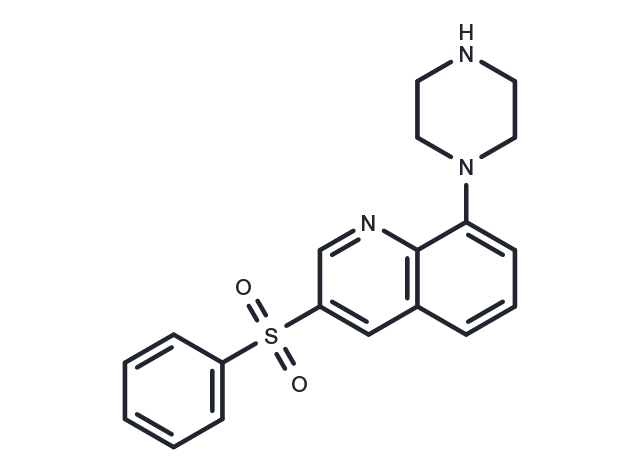Powder: -20°C for 3 years | In solvent: -80°C for 1 year


Intepirdine (GSK-742457) is a highly selective 5-HT6 receptor antagonist, used in trials studying the treatment of Alzheimer's Disease.

| Pack Size | Availability | Price/USD | Quantity |
|---|---|---|---|
| 5 mg | In stock | $ 68.00 | |
| 10 mg | In stock | $ 109.00 | |
| 25 mg | In stock | $ 222.00 | |
| 50 mg | In stock | $ 355.00 | |
| 100 mg | In stock | $ 563.00 | |
| 500 mg | In stock | $ 1,180.00 | |
| 1 mL * 10 mM (in DMSO) | In stock | $ 75.00 |





| Description | Intepirdine (GSK-742457) is a highly selective 5-HT6 receptor antagonist, used in trials studying the treatment of Alzheimer's Disease. |
| Targets&IC50 | 5-HT6:9.63(pKi) |
| In vitro | SB-742457 is a selective 5-HT6 receptor antagonist with cognition, memory, and learning-enhancing effects. [2] SB-742457 is a novel cognitive enhancing agent for Alzheimer's disease. SB-742457 is a potential agent added to stablize donepezil treatment in subjects with mild-to-moderate Alzheimer's disease. [1] |
| Kinase Assay | In vitro kinase activity assay: EGFR kinase: Each 100 μL enzyme reaction contained 10 μL of inhibitor in 50% Me2SO, 20 μL of substrate solution (200 mM HEPES pH 7.4, 50 mM Mg-acetate, 2.5 mg/mL poly (EY), 5 μg/mL bio-pEY) and 20 μL enzyme preparation. The enzymatic reaction is started by addition of 50 μL of a 100 μM ATP solution made in 10 mM MgCl2. Assays are carried out at room temperature for 30 min and terminated by the addition of 50 μL of stop solution (250 mM EDTA in 20 mM HEPES pH 7.4). 100 μL are transferred to a streptavidin coated microtiterplate, after an incubation time of 60 min at room temperature the plate is washed with 200 μL of wash solution (50 mM Tris, 0.05% Tween20). A 100 μL aliquot of a HRPO- labeled anti-PY antibody (PY20H Anti-Ptyr:HRP ) 250 ng/mL are added to the wells. After 60 min of incubation, the plate is washed three times with a 200 μL wash solution. The samples are then developed with a 100μL TMB Peroxidase Solution (A:B= 1:1). The reaction is stopped after 10 min. The plate is transferred to an ELISA reader and extinction is measured at OD450 nM. HER2-IC enzyme: Enzyme activity is assayed in the presence or absence of serial inhibitor dilutions performed in 50 % Me2SO. Each 100 μL reaction contains similar components as described for EGFR kinase assay with addition of 1000 μM Na3VO4. The enzymatic reaction is started by addition of 50μL of 500 μM ATP solution made in 10 mM Mg-acetate. The dilution of the enzyme is set so that incorporation of phosphate into bio-pEY is linear with respect to time and amount of enzyme. The enzyme preparation is diluted in 20 mM HEPES pH 7.4, 130 mM NaCl, 0.05% Triton X-100, 1 mM DTT and 10% glycerol. Assays are carried out at room temperature for 30 min and terminated by the addition of 50 μL of stop solution. Src kinase assays: Each 100 μL reaction contained 10 μL of inhibitor in 50 % Me2SO, 20μL of enzyme preparation, 20 μL of substrate solution supplemented with 1000 μM Na3VO4.The enzymatic reaction is started by addition of 50 μL of a 1000 μM ATP solution made in 10 mM Mg-acetate. BIRK kinase assay: 250 mM Tris pH 7.4, 10 mM DTT, 2.5 mg/mL poly(EY), 5 mg/mL bio-pEY is used as substrate solution and enzymatic reaction is started by addition of 50 μL of a 2 mM ATP solution made in 8 mM MnCl2, 20 mM Mg-acetate. VEGF2 and HGFR kinase assays: Assays are carried out at room temperature for 20 minutes and terminated by the addition of 10 μL of 5 % H3PO4. The precipitate is then trapped onto GF/B filters using a 96 well filter mate universal harvester. After extensive washing the filter plate is dried for 1 h at 50°C, sealed and incorporated radioactivity is determined by scintillation counting using a TopCount? or a Microbeta b counter?. |
| Synonyms | RVT-101, SB 742457, GSK-742457 |
| Molecular Weight | 353.44 |
| Formula | C19H19N3O2S |
| CAS No. | 607742-69-8 |
Powder: -20°C for 3 years | In solvent: -80°C for 1 year
Ethanol: 2 mg/mL (5.65 mM)
H2O: < 1 mg/mL (insoluble or slightly soluble)
DMSO: 72 mg/mL (203.7 mM)
You can also refer to dose conversion for different animals. More
bottom
Please see Inhibitor Handling Instructions for more frequently ask questions. Topics include: how to prepare stock solutions, how to store products, and cautions on cell-based assays & animal experiments, etc.
Intepirdine 607742-69-8 GPCR/G Protein Neuroscience 5-HT Receptor GSK 742457 Inhibitor inhibit 5-hydroxytryptamine Receptor Serotonin Receptor SB-742457 RVT-101 RVT101 GSK742457 SB 742457 GSK-742457 RVT 101 SB742457 inhibitor
